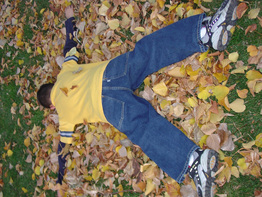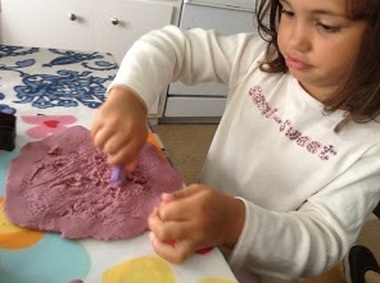Tactile Based Play
The brain learns to accept and process tactile input
in a certain sequence...
When you hear the word tactile, think touch and texture. The tactile system includes the entire network of skin, including inside of the mouth. The tactile system is quite complex and the nervous system processes different types of tactile input via different pathways to the brain, therefore a child may tolerate one form of tactile input just fine, but completely disgusted by another. Deep pressure touch is the most accepted form of tactile input overall. Visit this page for a few how-to videos on deep pressure touch activities. Deep pressure touch can also be achieved via different sensory tools, such as a sensory retreat, weighted products, compression clothing, or even some swings such as a cuddle swing.
Then you have all of the other forms of tactile input...from light touch to various textures and mediums. And the brain experiences this differently based on where the input is received...such as to the hands or feet, the back, face, the entire body or any combination in between.
The brain learns to accept and process tactile input in a certain order. It is incredibly important to assess this and follow this process to avoid uncomfortable and possible set backs for tactile system development. This is particularly important for children who demonstrate tactile defensiveness. This includes picky eaters and those with feeding challenges.
It is best to follow this sequence, assessing how your child responds to each different type of texture. Begin with DRY textures, watching to see that the child accepts and tolerates play to the hands and feet with at least 3 different varieties of DRY textures. Then move on to the IN BETWEEN textures, and then on to MESSY textures.
Full body tactile activities are incredibly powerful and therapeutic for the tactile system and sensory integration overall. Please note that full body tactile experiences should only be given a try, if and when the child is ready...this is even more important when referring to messy textures.
Then you have all of the other forms of tactile input...from light touch to various textures and mediums. And the brain experiences this differently based on where the input is received...such as to the hands or feet, the back, face, the entire body or any combination in between.
The brain learns to accept and process tactile input in a certain order. It is incredibly important to assess this and follow this process to avoid uncomfortable and possible set backs for tactile system development. This is particularly important for children who demonstrate tactile defensiveness. This includes picky eaters and those with feeding challenges.
It is best to follow this sequence, assessing how your child responds to each different type of texture. Begin with DRY textures, watching to see that the child accepts and tolerates play to the hands and feet with at least 3 different varieties of DRY textures. Then move on to the IN BETWEEN textures, and then on to MESSY textures.
Full body tactile activities are incredibly powerful and therapeutic for the tactile system and sensory integration overall. Please note that full body tactile experiences should only be given a try, if and when the child is ready...this is even more important when referring to messy textures.
DRY Textures...
IN BETWEEN Textures...
MESSY Textures
Dry Texture Play Ideas:
- Dry beans, lentils, corn, rice, etc
- Grass, leaves, tree bark
- Different fabric textures
- Wood chips, rocks and pebbles
- Sand or dirt
"In Between" Texture Play Ideas:
(Textures that are not dry, yet do not adhere to the skin)
- Playdough
- Clay
- Moon sand
- Cooked noodles
- Squishy type fidget toys
- Theraputty
- Water beads and crystals
Messy Texture Play Ideas:
- Non-dairy pudding or yogurt
- Natural finger paints
- Organic shaving cream
- Mud



